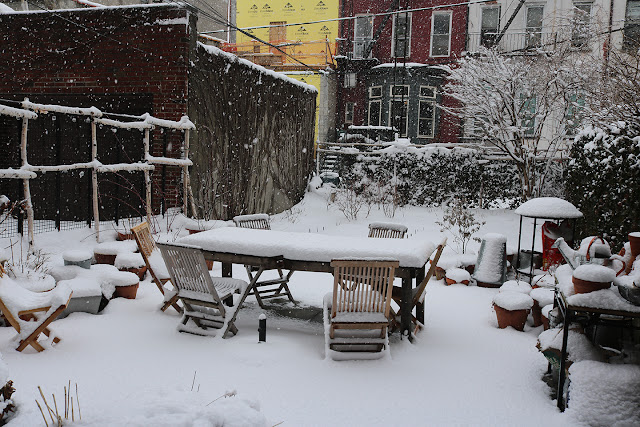March 2018
Eeeeeeeeeeeee, wheeeeeee, whrrrrrrrrrr, vvvvvvvvvv, ghghghgh,
merde!
Ah, the sound of a metal drill bit meeting heart of oak. Performance by Frenchman. Along with the song of the American robin, newly returned and caroling from the rooftops well past dusk, it is a true sign of spring.
This is the late winter, early spring garden. It is drab. It looks sad. Without distracting foliage the poured concrete slab dominates. And the legs of the townhouse's fire escape always get in the way of pictures from the kitchen door. But that is a year-round problem.
July 2017
Our garden table is used often in nice weather - mid spring to late fall. We eat outside every night. It's hard to remember that, after months of winter, when we live indoors with the warm light of lamps.
I bought the table on Etsy soon after we moved into our new apartment, two-and-a-half years ago. It was made to order from reclaimed oak and shipped from the hinterland. I had fallen in love with the advertised pictures, but when a progress-picture of the new table was sent it revealed six legs. Six legs! Not four. Apparently the advertised table also had six but they were successfully hidden by surrounding chairs. I hated it. The proportions were all wrong. It looked like a long low animal, or an amputated centipede. I squeaked. The very responsive Etsy vendor replied at once that it could be fixed and the offending middle legs were removed and the middle reinforced. He said it would be fine as long as I did not stand on it. I have not stood on it. And actually that aspect has held up fairly well. What has not done well is the planks on top, which have been warping and lifting up, the wood levitating from the slender nails.
March 2018
The table is out in all weathers, of course - sun, rain, snow. But that was made clear before I placed my order. The same vendor sent us replacement planks at no cost. I am sure this table cost them more than they made, in the end. But I also think this might have been a work in progress for them and a costly lesson in...something. Don't deal with New Yorkers? I absolutely cannot fault their customer service. Their tables would be best protected from weather.
Anyway. So it was time to replace the middle two planks, and this the Frenchman did, killing a drill bit in the process. The wood is truly hard. He has been using screws that hold the wood better than nails.
So, spring. On its way. Even though it snowed on April 2nd and will snow again on April 7th!
Also on their way to our door are a finger lime from California and
myoga (
Zingiber mioga - Japanese ginger) I ordered from Oregon. I have loved
growing ginger as an annual crop and am hopeful that myoga will be winter hardy in a large pot. I am after its flower buds, a delicacy. A person can dream... But a girl who came on one of my foraging walks told me she grows myoga on a Manhattan terrace. So.
Last year's edible Asian experiment (also from Oregon, maybe that should tell me something) crashed and burned, or sank and sogged:
my wasabi plants are toast (mush). I decided to leave them in their pot outdoors, covered by mulch and protected near the house. But they succumbed. I knew the risk was very high but had to take it for the sake of accurate reporting. Oh, dear.
RIP - August 2017
Also toast-mush? My pineapple lilies (Eucomis) that I left in pots, mulched and covered with clear plastic to stop snow from slowly rotting them. They rotted anyway. Allegedly hardy to USDA Zone 7. That's us. But they are not hardy for me in pots. Would they have fared better in-ground? We had killer low temperatures (below 0'F) in January. Fortunately I lifted some and they are fine in the fridge's crisper drawer. Another lesson learned. Call me your Horticultural Guinea Pig.
Along with the robin, yesterday I spotted a wood thrush in the garden - very exciting. First time. Rooting around near a pile of brush I have created to attract insects. It's a backpackers' version of an insect hotel (has anyone ever
seen an insect in an insect hotel?). And after a brief return,
Gordita the eastern towhee has disappeared again. Damn. She was funny - fat and unafraid, unlike the stupid sparrows who still fly away as though I was an axe murderer. I feed you, you idiots. Untrainable.
What is the sound of your spring?
_________________

















